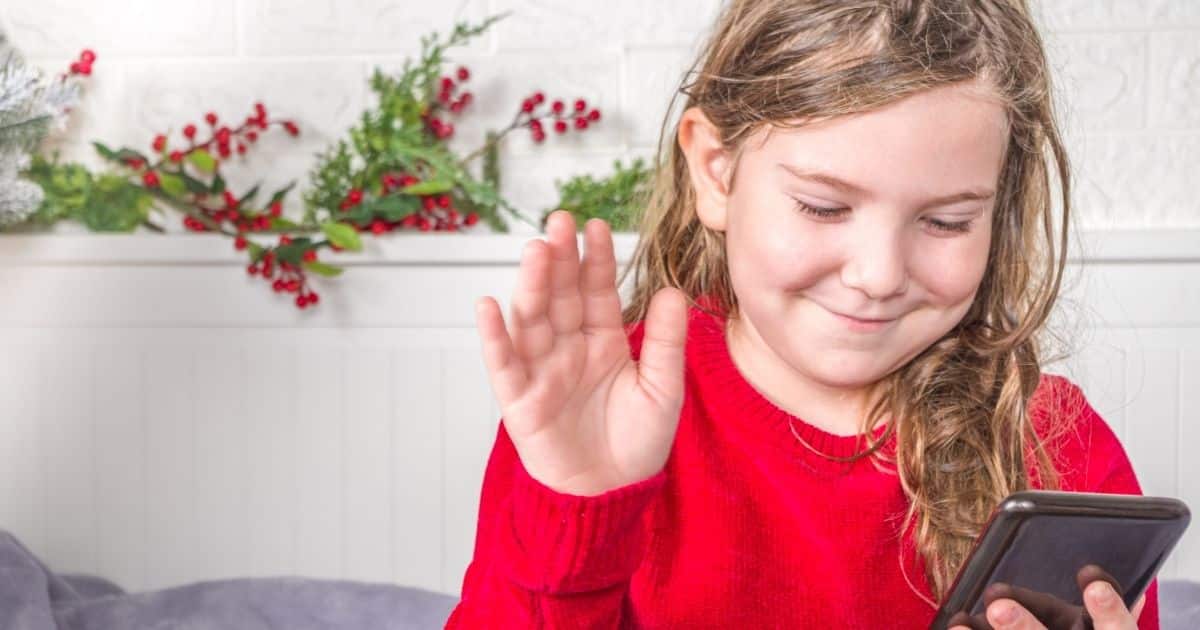
Contents:
Australia is a nation addicted to mobile phones, and that includes Aussie children. The Australian Communications and Media Authority’s Kids and mobiles interactive report shows that:
"Almost half (48%) of children aged 6-13 now own or use a mobile phone, with 1 in 3 owning the phone they use."
So while thinking about getting a phone for their child this Christmas can feel like a big step for many parents, allowing your child the use of their own phone is pretty normal these days. And, it can be a great way to foster independence and responsibility in kids.
Of course, it can also be expensive if you choose the wrong device but thankfully not every phone comes with a sky-high price tag, and not every child needs the latest and greatest in smartphone technology to stay connected.
Here are a few suggestions on what to look for in a child-friendly phone and some devices you could consider getting that won’t break the bank.
Further reading: Should I get my child a phone, or not?
Determine the purpose of the phone
When selecting the perfect phone for your child, it's crucial to start by determining its primary purpose.
Ask yourself whether the phone will primarily serve as an educational tool, an entertainment device, a means for socialising with peers, or as a communication lifeline connecting your child with you, their school, and emergency services.
Defining the purpose will help you make informed decisions about factors like the phone's features, budget, and durability.
Whether it's fostering learning, ensuring safety, or providing entertainment, understanding the phone's role in your child's life is the first step towards making the right choice.
Work out your budget
No matter what advertisers say to guilt-trip you into buying your precious child the latest, most advanced smartphone, kids do not need an expensive, high-end phone. Especially when there is a high chance it will get lost or broken.
So, regardless of whether you are on a single income or have more leeway to get a better gadget for your child, getting something affordable for their first phone is the way forward.
What's great is that even the cheapest smartphone options today can run several basic applications your child might need.
Determine how much you can afford to set aside from your family's budget for your child's phone and stick to it. Remember, a phone is not a one-time purchase. You need a cellular plan so your child can call, text, and access the Internet - which are why you're getting a phone in the first place.
Budget is one of the most important factors to consider when getting your child a phone for Christmas.
Consider pre-owned or refurbished
As I previously said, kids do not need expensive phones. They - well, all of us - also don't need new ones!
One incredible thing that recently exploded worldwide is buying secondhand, with Gen Zs leading the pack. If you're concerned about technology waste and having a lower carbon footprint, a pre-loved or refurbished phone is an excellent option for your pocket and the planet.
When it comes to pre-owned or refurbished phones, I highly recommend checking out PhoneBot and Green Gadget. You will find good secondhand iPhones and Androids for as low as a couple of hundred dollars with these sustainability-minded Aussie companies.
Handset durability
I was a very physically active and particularly clumsy child, so I know that my phone would not have lasted long if I had one back in the day. I would have dropped it, sat on it, or accidentally submerged it some form of liquid. Even that trusty Nokia 3310 wouldn't have stood a chance.
That's normal, and that's why you don't get kids high-end phones.
Children are not known to be the most careful bunch, so keep durability in mind when searching for a phone. Sleek iPhones and Android phones are beautiful and fashionable, but they also need careful and mindful handling.
It's nice to know that waterproof and shockproof rugged phones exist today. They're built to withstand the harshest conditions and handling, so think of them if you want a phone that allows your kids to be kids.
Age appropriate features
Age-appropriate features are pivotal when making the big decision of getting your child a phone for Christmas.
Consider factors such as a sizeable, easy-to-read screen to protect their eyes from strain. GPS tracking and locator functions enhance safety, allowing you to monitor their whereabouts. Parental controls and content filtering are indispensable for shielding young users from inappropriate content and managing screen time.
Look for phones with a simple interface and restricted access to sensitive settings. These features ensure that the device aligns with your child's age and maturity level, providing a secure and controlled digital environment where they can learn, explore, and communicate safely.
Phone battery life
Have you heard about old Nokias still running on charge after decades of being turned off? How I wish they would make phone batteries like that again!
Kidding aside, solid battery life is not just to ensure your child can run her favourite apps and watch videos uninterrupted during long trips. More importantly, you need it in case of emergencies and power outages. Remember to ask about battery life when shopping for your child's phone.
Thankfully, manufacturers nowadays are doing everything to make their phone batteries long-lasting, which is a good thing for us mums, since we have a lot more options.
By the way, lithium batteries' lifespan typically lasts 2 to 3 years, after which they drop. But you can also teach your kids some tricks to keep their phone's batteries healthier by not downloading and running so many apps and regularly optimising their phones.
Operating system (iOS Apple or Android)
Historically, Aussies seem to prefer Android phones, although Apple's iOS is seeing a significant rise in market share this year. You can be a fan of one or the other, but which operating system is better for your child?
I'm far from being a tech expert, but based on my research, Android wins as the operating system for a kid's phone. Google's Android allows parents to monitor and control their children's phone use. As a mum, you can set parental rules on their digital life.
Meanwhile, iOS is impeccable when it comes to security and privacy, yet these features do not discriminate whether the user is a child or an adult. I mean, upholding your child's privacy is crucial, but that also means she is more susceptible to accessing harmful content without proper guidance.
Camera quality
Frankly, I don't think camera quality is crucial for kids' phones. You'll probably be taking photos of her from your phone more than her.
But if your child, especially your teen, is fond of documenting her childhood or is interested in photography, a nice camera would be a important addition to your list of things to look for.
Today, even phones on the lower end of the price spectrum have decent cameras. However, remember that saving many photos will take up lots of storage and make the phone run slower. You should install an SD card or automatically sync your child's photo gallery to the Cloud.
Parental controls
I have already touched on this in the topics of age-appropriate features and operating system, but that's because it's that important. The Internet despite its benefits can be a scary and dangerous place, so parental control features is high up on many mums's criteria.
The thought of monitoring my teenage daughters' phone activities and messages from my device is some Black Mirror-level spin in my book. But I also have a good friend who used to do it to protect her kids, so no judgements here.
While many of us mums don't go to such lengths, there are still other ways to protect our children from dangerous content on the Internet. Think compatibility with kid-safe apps and parental control apps, like turning off social media, blocking software downloads, and setting device limits.
Whether or not you're keen on having controlling and monitoring your child's phone, it's important to educate her on proper and responsible Internet use beforehand.
Storage capacity
If you're looking for a phone that goes beyond the basic functions, you should also check storage capacity. It's needed for downloading and runnings apps and software, saving photos, and reading files offline.
Although your kids don't need a lot of storage space on their first phones, it is a necessity if they want to customise their wallpapers and fonts. It's also needed when updating the software; when you have a small storage space, your phone will slow down faster.
Remember to teach your children to manage their storage space responsibly. As a mum, you should guide your kids on how to manage storage effectively, delete unnecessary files, and be cautious about downloading large files or apps that could quickly fill up the device's storage.
Furthermore, you can set storage limits and monitor your child's device usage to ensure it aligns with your family's phone rules.
Prepaid vs. postpaid phones
Another equally important factor when getting your child's first phone is whether you will get prepaid or postpaid plans. As I mentioned earlier, a phone is not a one-time purchase. You have to buy cellular data to make it function, too.
Prepaid and postpaid plans have their respective pros and cons. Prepaid plans ensure that your children will learn to control their usage. The downside is that they cannot communicate with you once they reach their limit. On the other hand, postpaid plans ensure seamless communication throughout the month, but uncontrolled usage will lead to additional fees.
As for me, I got my daughters' postpaid phones with the most basic cellular plan. It was scary at first, as I constantly worried they would exceed their limits. Thankfully, they never did. I carefully explained to them the inclusions of their plan and the consequences if they go overboard. (That is, they will have to pay for top-up from their allowance.)
Warranty and insurance
Finally, you should also check the availability of warranty and insurance. Most phones sold in official stores come with a warranty, while cellular plans also offer device insurance.
If you are considering buying a slightly expensive phone, I highly recommend getting gadget insurance. Although it seems unnecessary for a first phone, warranty and gadget insurance can give you peace of mind about the likelihood that your child's phone will be damaged, especially since she's bringing it to school.
I wish I had this advice when I got my daughters' first phones. In the first two weeks, my youngest came home with a broken screen that we had to repair. What a hassle!
Final words: Choosing the right phone for your child this Christmas
Choosing a phone for your child this Christmas is a multifaceted decision that involves considering their unique needs and circumstances.
By carefully weighing factors such as durability, storage capacity, age-appropriate features, and budget, you can provide your child with a device that enhances their safety, education, and entertainment.
Ultimately, the goal is to strike a balance between technology's benefits and responsible usage, ensuring that the chosen phone supports your child's growth and development while offering peace of mind for us parents.













